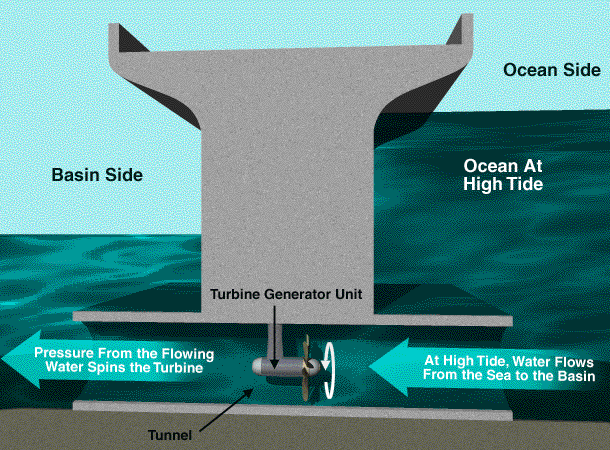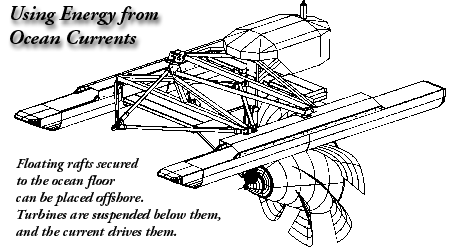|
|
CONCEPTS
- The sources for 90% of the electric energy generated today are non-renewable:
the burning of coal, oil, and natural gas.
- Renewable, non-polluting sources are hydroelectric,
windmill, solar, and geothermal.
- Ideas for harvesting tide power -- a renewable and clean energy source
-- have been around for hundreds of years.
- A tidal power plant has been operating in France since 1966.
|
|
| |
PROCEDURE
|
|
Engagement
|
|
| |
 |
Since 1966, tidal power plant at La
Rance River in France. Tidal range there is up to 13.4 meters.
The dam's width is 760 meters (nearly 0.5 miles).
At high tide, the dam traps Atlantic waters in the bay.
At low tide, the water flows back to the sea. En route, it
passes through 24 turbines connected to generators that produce
240 megawatts of power. This provides enough electricity for
a city of 300,000. (Click here
to see a "side view" of this.)
In 1997, they began installing turbines that can spin on
both the incoming and outgoing tides.
|
|
|
| |
Activity
- The higher the tides, the more electricity can be generated
from a given site, and the lower the cost of electricity produced.
Worldwide, approximately 3000 gigawatts (1 gigawatt = 1 GW = 1
billion watts) of energy is continuously available from the action
of tides.
- Experts estimated that only 2% (60 gigawatts) can potentially
be recovered from tides for electricity generation.
- Can you guess why this is the case?
- Currently, only in places with large tidal
range (greater than 5 meters) can tidal power be extracted
economically. Visit the Oceanographic
Products and Services Division website to find whether any
stations along the U.S. northeast coast have a tidal range of
5 meters or greater.
- Click here
to plot yesterday's water levels along the U.S. northeast coast.
- To get yesterday's "Water Level" data:
- Either click any station's red dot or use the "pull-down"
menu
- Click on the "Water Level Plot" button (lower
left)
- Hit the "SUBMIT" button
- After you've hit "SUBMIT," you may get a "warning
message" that says "Any information that you
submit is insecure..." Hit "OK" to continue.
- You may not have time to check all thirteen available stations.
If this is true, you may want to check every other station or,
perhaps, every third station. Keep in mind, it is important
to sample over a fairly wide geographic range of stations.
- Assess whether of the stations you researched any meet the 5-meter
tidal range requirement.
- If any do, categorize them as "OK SO FAR."
- If possible, print the "water level plots" for these
"OK SO FAR" stations. (You will use them in Step 6.
If you cannot print the data, write down the times of high and
low tide for these stations.)
- Locate the "OK SO FAR" stations on an atlas.
- In order to harvest tidal power, a structure must be built across
a tidal bay or estuary. Because building
these is expensive, the best sites are those where a bay has a
narrow opening (thus reducing the length of dam).
- Do any of your "OK SO FAR" stations have narrow
openings where such a structure could be built? (Please continue
even if the answer is "no.")
- If yes, how might such structures affect local habitats of
wildlife? Salmon migration?
- If yes, how might sediment that is trapped upstream of the
structure affect an estuary?
- Considering these potential impacts, are any of your stations
still "OK SO FAR"? (Please continue even if the
answer is "no.")
- At certain points along the dam, gates and turbines are installed.
After the dam is completed, when there is an adequate difference
in the elevation of the water on the either side, the gates are
opened. This causes water to flow through the turbines, turning
an electric generator to produce electricity. (Click
here to see a "side view" of this.)
- To demonstrate how a turbine works, ask a student volunteer
to blow on a pinwheel. Be sure that he or she blows toward its
circular face (not on the pinwheel's "sides").
- At first he or she should blow lightly and note the rate
the pinwheel turns. Then he or she should blow harder. How
much faster does the pinwheel turn? Which "blowing
rate" would produce more energy?
- Note that sea water has a much higher (832 times greater)
density than air. Thus, currents running at velocities
of 5 - 8 knots (9.25 km/hr -
16.7 km/hr) have the same energy potential as a windmill
site with windspeeds of 390 km/hr!
- At the La Rance tidal power station (see "Engagement"
section), they have installed turbines that can spin on both
the incoming and outgoing tides.
- Have a student alternatively blow on opposite sides of
the pinwheel's circular face.
- Does it turn correctly in both cases?
- Examine the design of the pinwheel's "blades"--
do they look the same on opposite sides?
- Given the results of this experiment, what can the
students conclude about the design of La Rance's new
turbines?
- Look at the water level plots (or high / low tide data) produced
in Step 3.
- Would tidal energy plants at these locations be able to generate
power 24 hours per day?
- In terms of timing, do you think that the supply of electricity
from any tidal power plant would match the customer demand?
- A "tidal fence" has been prosed
as a alternate design to the tidal turbine-dam
design.
- One advantage of a tidal fence is that all the electrical
equipment (generators and transformers) can be kept high above
the water.
- Scroll down to see the designs for the "tidal turbine-dam"
and "tidal fence."
- Can you name the advantages or disadvantages of one
design over the other?
|
|
| |
Explanation
- Over the past forty years, there has been constant interest
in harnessing tidal power. Initially, this interest focused on
estuaries, where large volumes of water pass through narrow channels
generating high current velocities. But, increasingly the environmental
costs of such a design became clear. Reduced tidal range would
destroy much of the habitat used by wading birds, fish (such as
salmon) would be unable to travel upstream to breed, and sediment
trapped behind the barrage could quickly reduce the volume of
the estuary. By the early 1990s, interest in estuarine-derived
tidal power had declined, and scientists and engineers began to
look at the potential of coastal currents.
- Tidal fences effectively block channels and if deployed across
the mouth of an estuary they can be very environmentally destructive.
However, in the 1990s their deployment in channels between small
islands or in straights between the mainland and island has increasingly
been considered as a viable option.
- According to experts, there are many sites around the world
where tidal turbine dams would be effective. They believe the
best sites could generate more than 10 megawatts of energy per
square kilometer. The European Union has already identified 106
sites which would be suitable for the turbines, 42 of them around
the United Kingdom.
- The more expensive that conventional sources of energy (coal,
gas) become, the greater the interest in harvesting energy from
the ocean will become. The hope is that future improvements in
technology will make building "ocean power plants" feasible.
|
|
EXTENSION
- Where are the world's highest tidal ranges found? Research whether
or not there are operating tidal power plants in this location. If there
are not, why not?
- Another potential method for harvesting the energy that resides in
the oceans involves taking advantage of the temperature differences
that exist between surface waters and deeper waters. Have the students
research where in the world's oceans this might be plausible?
- Click here to see one way that ocean
current power might be harvested. Can the students develop other "current-power"
designs?
|
|



